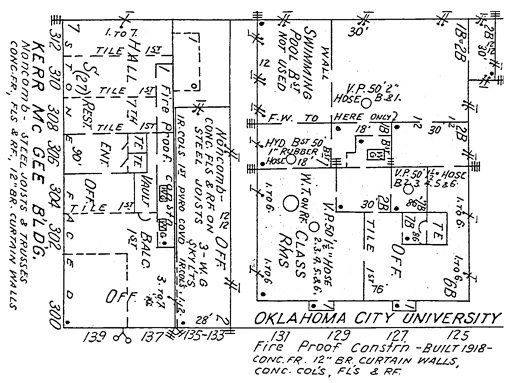Updated May 5, 2010, to include new information
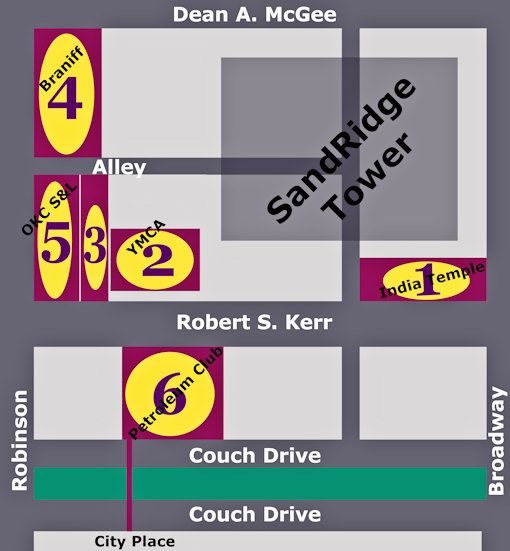
All but one of the buildings identified above (#4 Braniff Building being the exception) is marked for demolition in the SandRidge proposal pending before the Oklahoma City Board of Adjustment (BOA) following the plan’s approval by the Downtown Design Review Committee (DDRC) on April 8, 2010.
SandRidge Energy Corporation and its project architect, Rogers Marvel, have brilliantly presented their beautifully designed plan called SandRidge Commons showing what the city would have to gain if its proposal, already approved by the DDRC, is also given the blessing of the BOA without modification. A May 20, 2010, 1:30 p.m. hearing by the BOA at the City Council Chambers will decide the call.
As far as I’m able to locate, a comprehensive counterpoint presentation showing what the city would have to lose if the BOA affirms the DDRC decision has not been presented on the internet. As I’ve already described, the India Temple is the building in SandRidge’s proposal that I’m most inclined to hug, but this article goes beyond my personal preference to present each significant building involved in the BOA’s decision. The appeal setting before the Board of Adjustment was previously described here.
| What Have We Got To Lose? | ||||
 |
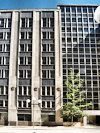 |
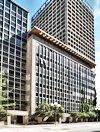 |
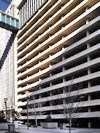 |
 |
| Oklahoma City S & L |
Other Building |
YMCA | Petroleum Club |
India Temple |
ORIENTATION. For those not familiar with the downtown area involved, it might be helpful to visually see the square block-plus that will be radically changed by the SandRidge proposal. The following aerial views are from Microsoft’s Bing, with color modifications for emphasis. The salmon-colored buildings would be destroyed.
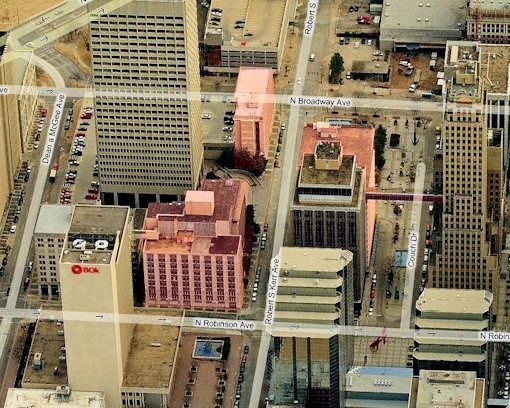
Looking north toward Dean A. McGee Avenue
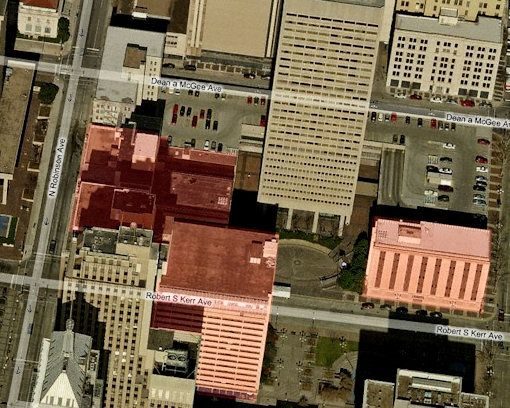
Looking south toward Robert S. Kerr Avenue & Couch Drive
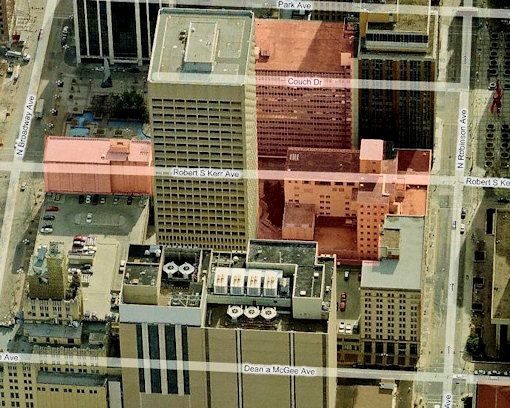
WHAT’S NOT DESTROYED — THE BRANIFF BUILDING. The sole survivor of historic buildings in SandRidge’s proposal is the Braniff Building. Click on any small image below for a larger view.
In 1927 (OHS image)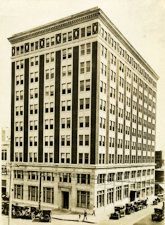 |
In 1941 (OHS image)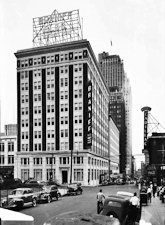 |
In May 2010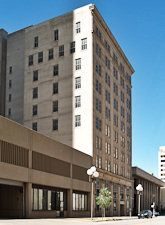 |
This 1923 building located at the southeast corner of Robinson and Dean A. McGee avenues was designed by Solomon A. Layton. I may add more about the building later but, for now, this will do.
OKLAHOMA CITY SAVINGS & LOAN. With its first three stories built earlier, the building expanded to eight stories in 1928. It later became the Capitol Federal Savings & Loan building.
| During 1928 Construction (Okc Metro Library System photo) 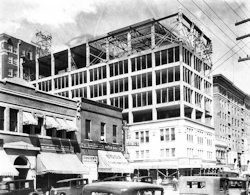 |
1930 (OHS Photo)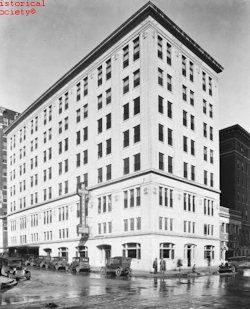 |
May 2010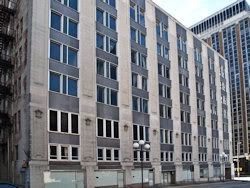 |
2008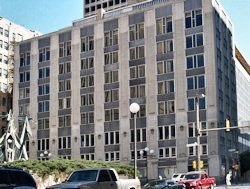 |
Notice that an east/west alley separates the Braniff Building on the north from the Oklahoma City Savings & Loan building on the south.
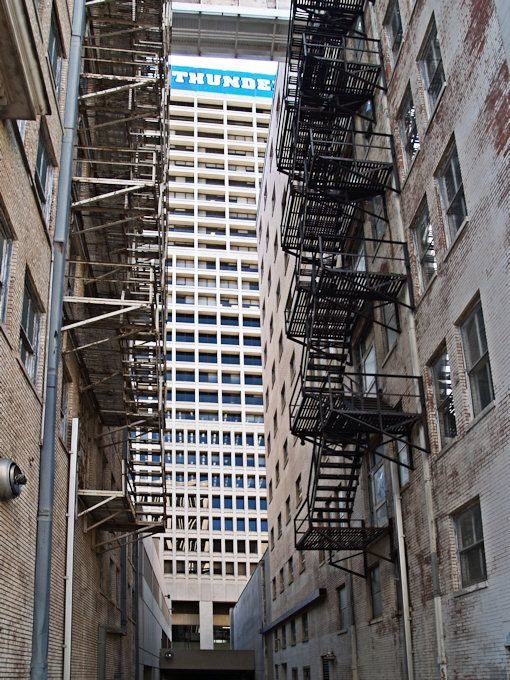
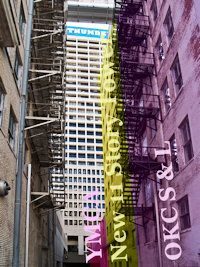 This touched-up version of the above shows the alley side of (1) the 1928 Oklahoma City Savings & Loan, (2) the 11-story tower added in 1957-58, and (3) the parking area extension to the 1918 YMCA building, also added in 1957-58. Click on the small image at right for a larger view.
This touched-up version of the above shows the alley side of (1) the 1928 Oklahoma City Savings & Loan, (2) the 11-story tower added in 1957-58, and (3) the parking area extension to the 1918 YMCA building, also added in 1957-58. Click on the small image at right for a larger view.
Originally, as you can see in 1949-1950 Sanborn Map Company map below, the alley extended for about 2/3 of the block where it intersected with a north/south alley which ran along the west side of the India Temple/Wright Building.
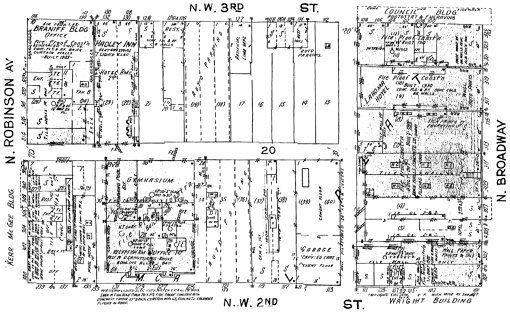
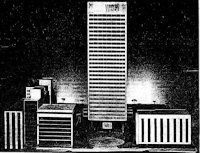 But, with Kerr McGee’s 1970 plans for its new campus and tower, parts of the alleys would be vacated. Click on the January 13, 1970, Oklahoman image at left for a larger view of Kerr McGee’s new campus, constructed during 1970-1973. Significantly, Kerr McGee’s plan for its new campus was not mutually exclusive of its own, or our city’s, heritage and legacy. With no disrespect to SandRidge or any of its principals intended, Kerr McGee, most particularly Dean A. McGee, was steeped in downtown’s history as well as invested in its future. As a reminder, the Myriad Gardens would most probably not have been accomplished as it exists today but for the singular efforts of Dean A. McGee for a project on the south-central side of downtown that wasn’t remotely near his own company’s campus or associated with his company’s identity. Create green space and a park for downtown? McGee was committed and determined to see that happen. Did it need to be part of his company’s identity and campus? No, not at all. Speaking from an Oklahoma City history vantage point, a humble suggestion to Oklahoma City’s corporate leaders might be, if you’re looking for a role model, think about trying to fit into Dean A. McGee’s shoes when you get up in the morning.
But, with Kerr McGee’s 1970 plans for its new campus and tower, parts of the alleys would be vacated. Click on the January 13, 1970, Oklahoman image at left for a larger view of Kerr McGee’s new campus, constructed during 1970-1973. Significantly, Kerr McGee’s plan for its new campus was not mutually exclusive of its own, or our city’s, heritage and legacy. With no disrespect to SandRidge or any of its principals intended, Kerr McGee, most particularly Dean A. McGee, was steeped in downtown’s history as well as invested in its future. As a reminder, the Myriad Gardens would most probably not have been accomplished as it exists today but for the singular efforts of Dean A. McGee for a project on the south-central side of downtown that wasn’t remotely near his own company’s campus or associated with his company’s identity. Create green space and a park for downtown? McGee was committed and determined to see that happen. Did it need to be part of his company’s identity and campus? No, not at all. Speaking from an Oklahoma City history vantage point, a humble suggestion to Oklahoma City’s corporate leaders might be, if you’re looking for a role model, think about trying to fit into Dean A. McGee’s shoes when you get up in the morning.
OTHER BUILDING. I’ve not yet figured out what to call this building which is sandwiched between the Oklahoma City Savings & Loan and YMCA buildings. [But, see May 5 Update. The building’s name in 1956 was the Culbertson building and it was destroyed by Kerr McGee when building its new 11-story tower.] The Staff Report identifies three of the buildings involved as follows:
300 N. Robinson (aka 135 Robert S. Kerr), Map Reference #2a … Historically known as the Oklahoma Savings and Loan Building, built 1928
135 Robert S. Kerr, Map Reference # 2b … Historically known as the YMCA building, built in 1918
125 Robert S. Kerr (aka 131 Robert S. Kerr), Map Reference # 2c … Historically known as the Capital Savings and Loan building [emphasis supplied], built 1924
In the above descriptions, notice that two buildings are shown with the same address, 135 Robert S. Kerr, and understand that the numeric value of these addresses should increase with further westbound locations. And, while I’m aware that the building originally named Oklahoma City Savings & Loan later became Capitol Federal Savings & Loan (that’s with an “o” not an “a”), I’m not aware that this “Other Building” had a similar name, or that it was built in 1924.
Let’s have a look at how the 1949-1950 Sanborn Map addresses these buildings:
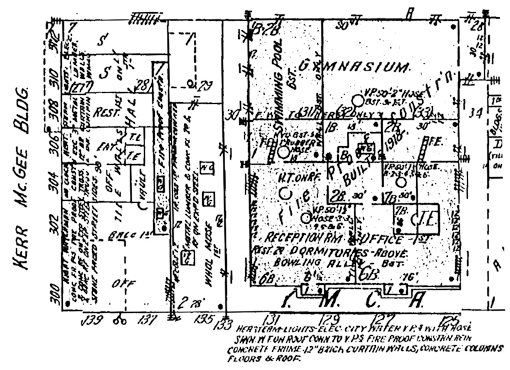
The small building is evident in the photo, probably taken in 1954 or 1955 … notice the corner building is now Capitol Federal … that’s a 1954 Oldsmobile in the foreground.
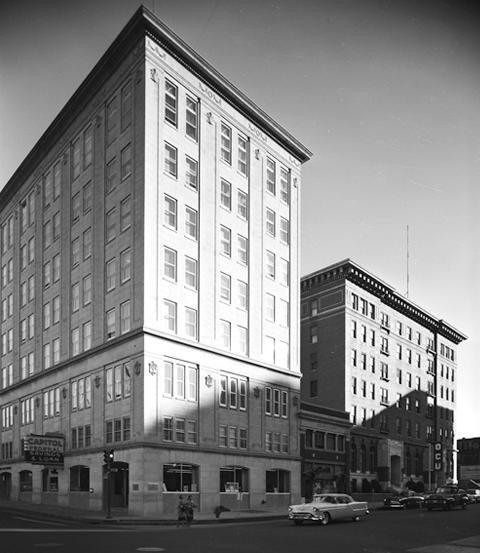
Now, compare the 1954-55 photo with one taken in 1960 …
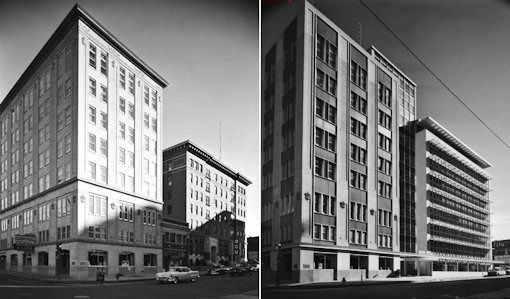
A better view of the 1960 OHS photo
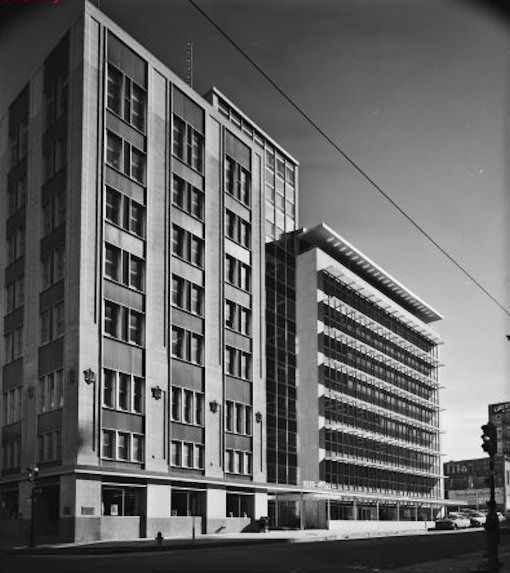
Not only has the “Other Building” undergone substantial change, so has the YMCA building at its east side. The smaller “Other Building” will be seen in a YMCA photo in the next section.
I’ll close this out with a photo that I took on May 2, 2010, showing the Oklahoma City Savings & Loan at left and the “Other Building” at the right. Although different, changes to the Oklahoma City Savings & Loan Building are less profound.
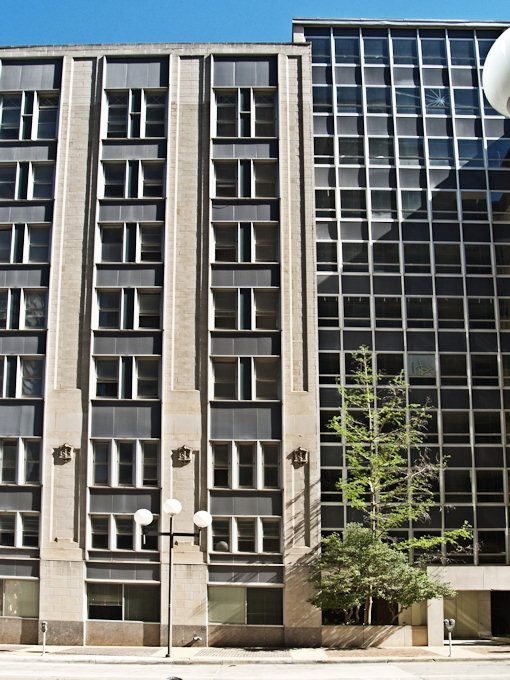
YMCA. The YMCA building sits immediately east of the “Other Building” and was built in 1918. It served as the YMCA until the newer YMCA at NW 5th & Robinson was completed in 1952. Ironically, the 1952 YMCA was also unnecessarily destroyed following the Murrah bombing. By the time the 1955 Sanborn Map was done, Oklahoma City University came to use the property, and the same is evident in the 1954 photograph shown in the preceding section.
The oldest actual photograph that I’ve located is from Bob Blackburn’s Oklahoma County – Heart of the Promised Land (Windsor Publications 1982). The good doctor got the photograph’s caption wrong where, at page 153, he wrote, “Located on 2nd Street between Robinson and Broadway, the YMCA Building served the organization for more than 30 years, before it was destroyed during urban renewal.” Well, it wasn’t destroyed, it was merely changed. It’s a comfort to know that even really-truly experts, like he is, make mistakes, sometimes. Anyway, the undated but apparently late-teens-early-1920s photo is at the left and a for sure 1920 Kress & Company postcard is at the right — for sure because I own it and it bears that postmark.
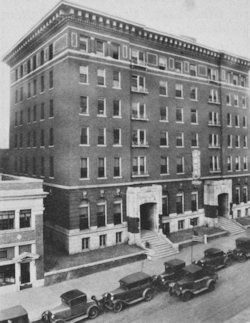 |
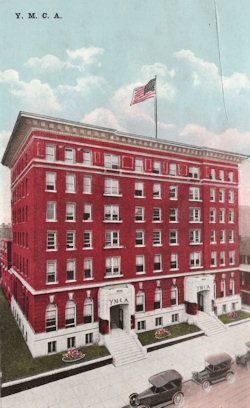 |
Underneath the surface, the old YMCA is still there but is presumably in a much different form. Photos taken on May 2, 2010, appear below.
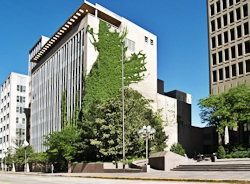 |
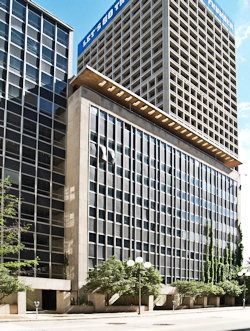 |
| MAY 5 UPDATE: I’ve done a little more digging and I am now able to take some of the guesswork out of what I’d earlier said.
1. The “Other Building’s” Name: The Culbertson Building. Whatever its name may earlier have been, by February 16, 1952, it was called the “Culbertson Building.” Yeah, I know … we already had a Culbertson Building on Broadway and Grand/Sheridan. You can call this one the “other” Culbertson Building. I’ll explain.
In any event, if, and that’s a big if, the Oklahoman article is reasonably accurate, the smaller Culbertson Building would have been constructed around 1936 plus or minus a few years. Well, maybe not. As you doubtless observed in early day YMCA images, the two-story building was present as early as around 1920. Particularly, see the 1920-ish image from Bob Blackburn’s book, and compare the crops from the 1955 image and that in Mr. Blackburn’s book below … it’s the same small building … 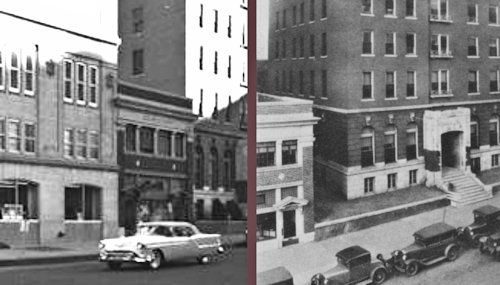 Not that it’s important here, but the original Culbertson Building was destroyed by Urban Renewal in July 1969, and a bird’s eye view of the then-sparsely populated south side of downtown shows up in the July 24, 1969, Oklahoman. Read the photo and weep: 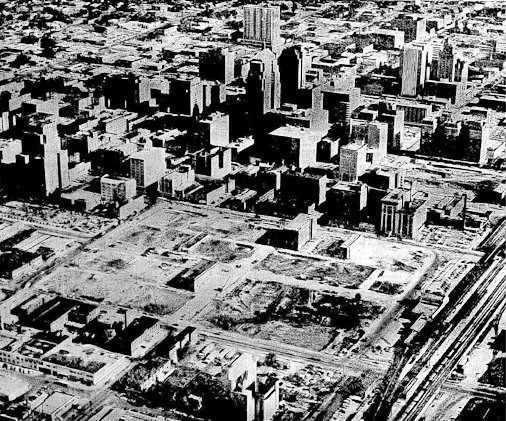 The wave of Urban Renewal’s destruction hadn’t reached its apex when the above July 1969 photo was taken. Sheridan/Grand pretty much marks the northern edge of the destruction in the 1969 view — even though south of that edge the original Culbertson, Biltmore and Oklahoma Club/Tivoli are still standing. North of Sheridan/Grand, and yet to get the hit, are the Lawrence and Kingkade Hotels, the Herskowitz, Huckins, Commerce Exchange, Baum, and other buildings which had not yet been called to judgment by the Urban Renewal Authority. That would come in short order. Now, back to topic. 2. Kerr McGee’s Makeover. A December 5, 1956, Oklahoman article describes Kerr McGee’s announcement to build a new office building, and those plans included the demolition of the Culbertson building:
A drawing of the new corporate headquarters appeared in the October 13, 1957, Oklahoman. Construction progress of the new 11-story building appeared in the November 4, 1957, Oklahoman … 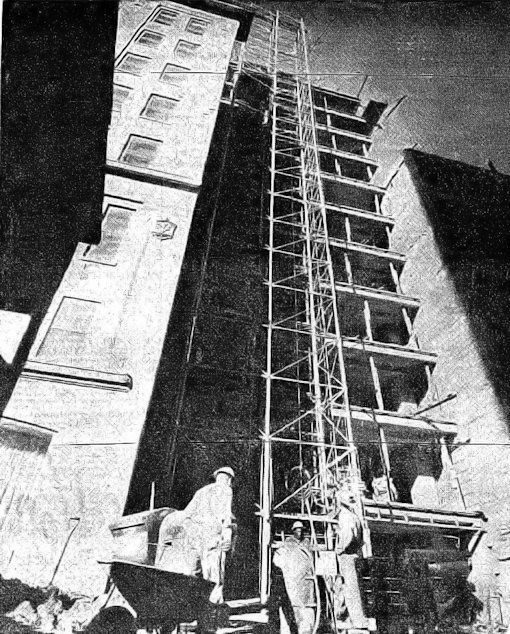 … and another construction photo, this one showing the new frontage on the YMCA building, appeared in the April 27, 1958, issue … 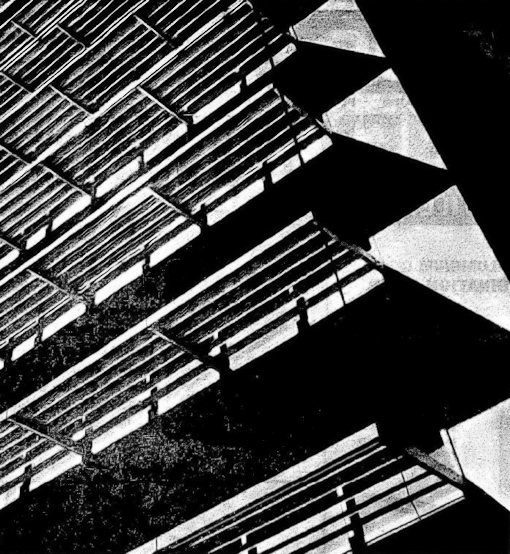 A rendering of the new complex appears in an April 26, 1959, issue as the new complex becomes ready for occupancy. |
PETROLEUM CLUB BUILDING. Although I’d not realized it until beginning to look at SandRidge’s pending proposal more closely, in addition to the block that is normally considered its campus, SandRidge also owns the Petroleum Club Building immediately south of the former YMCA building. Located at 120 Robert S. Kerr, the Petroleum Club building was built in 1957 by Liberty Bank (when Liberty was located in today’s City Place building). The upper floors of this 16-story building served as the home of the posh members-only Petroleum Club until it moved to newer quarters in Liberty (Chase) Tower when that new skyscraper opened on Broadway in 1970. A very high skywalk at the Petroleum Club building’s 14th floor connects with the 15th floor of City Place and is said to be the 1st skywalk in the city. For much more about this building, see this blog article written in March 2007.
Here are a few photos taken in 2007. As is typical in this article, click on any photo for a larger view.
Looking East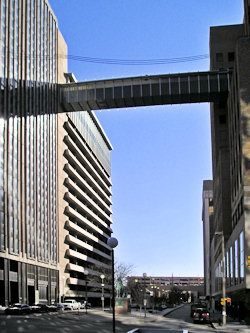 |
Looking West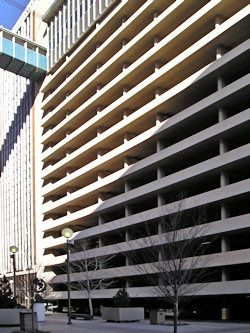 |
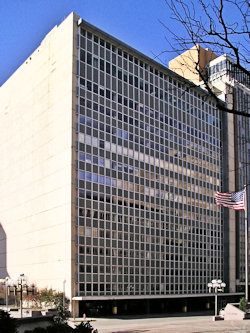 |
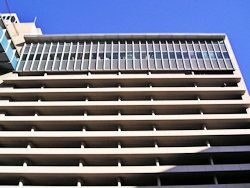 |
INDIA TEMPLE. I’ve already done my song and dance article focusing on the India Temple in Bye Bye Miss American Pie and I’ll try to avoid being redundant. Here, I’ll just give a few facts and several pictures.
The building’s original name was the India Temple, but it would have others, e.g., the Wright Building. The India Temple …
- … is the oldest surviving downtown building. Built in 1902, it survives other buildings which were razed during Oklahoma City’s Urban Renewal period such as the 1902 Culbertson Building and the 1903 Overholser Opera House (later Warner Theater). If this building is destroyed, the 1907 Lee (Oil & Gas) Building followed closely by the 1908 Pioneer Building will become downtown’s oldest surviving buildings.
- … served as the home of the Oklahoma Legislature from 1913-1917 until the new State Capitol Building was completed.
- … is salvageable AND restorable, according to hearsay reports … nothing that I can quote right now. A persuasive body of such hearsay information indicates that (a) contractor drawings and notes made when the property was modified to create its false front still exist and (b) it is indeed salvageable and could be substantially restored to its original condition — can you say Skirvin Hilton? Of course, SandRidge would either need to be willing to do this as a service to the city or sell the property to someone else who would have such a disposition. At the least, the hearsay information ought to be investigated closely, something which is as yet undone.
Here are the pics — click on any for a larger view.
Circa 1902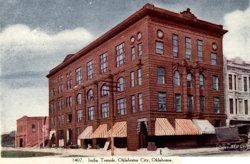 |
1903 (credit COC)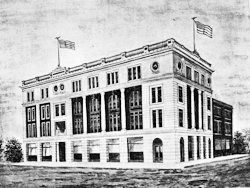 |
Circa 1902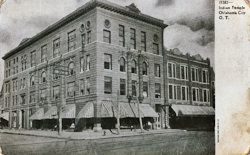 |
Circa 1902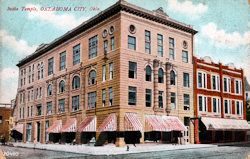 |
Circa 1902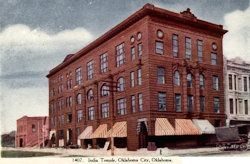 |
Circa 1906 (OHS photo)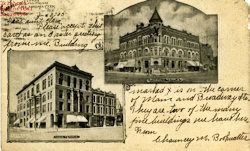 |
1930s (OHS photo)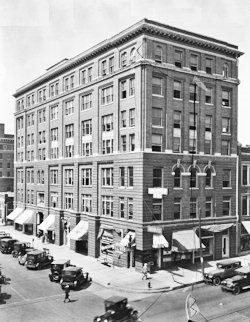 |
1940s (OHS photo)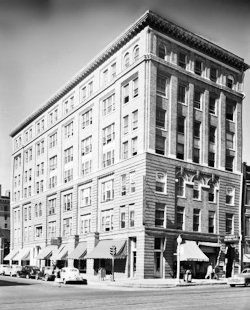 |
May 3, 2010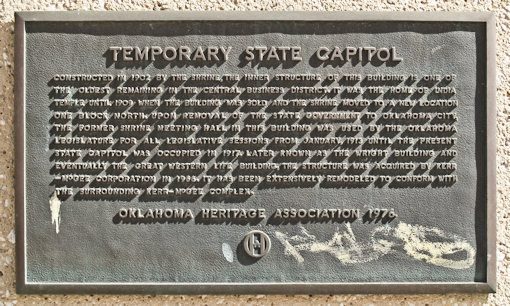 |
|
May 3, 2010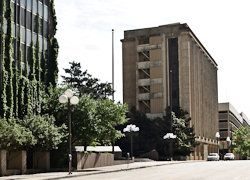 |
May 3, 2010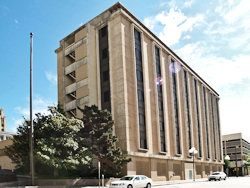 |
CUMULATIVE EFFECT. Forgetting history (for a moment), cumulatively speaking, if all of these buildings were stacked on top of each other, we’d be talking about destroying a 50-51 story skyscraper. [Note: when the chart below was initially prepared, I was unsure of the number of stories in the “Other” building but per the May 5 Update, the stories is now shown as 11 (not 8 or 9), the YMCA is shown as 9 (not 7). I’m still not absolutely certain whether the India Temple should be shown as 6 or 7.] Count the stories for yourself …
| Building Name | Minimum Stories |
Maximum Stories |
| OKC Savings & Loan | 8 | 8 |
| “Other” Building | 11 | 11 |
| YMCA | 9 | 9 |
| Petroleum Club | 16 | 16 |
| India Temple | 6 | 7 |
| Total Stories | 50 | 51 |
Is this REALLY what we want to do?
Related articles:
- Bye Bye Miss American Pie
- Appeal by Preservation Oklahoma
- Hugging Our SandRidge Buildings
- SandRidge Commons – What About Door #3?
- National Trust For Historic Preservation Weighs In
- SandRidge Commons – Round 2
- SandRidge – Holder of a Legacy
- SandRidge & Restoration

